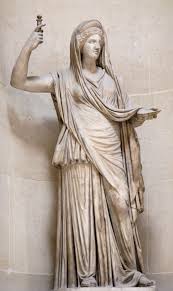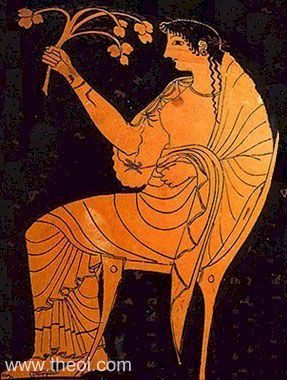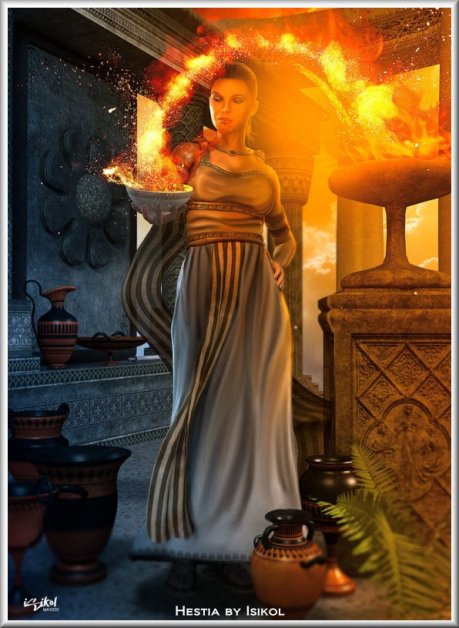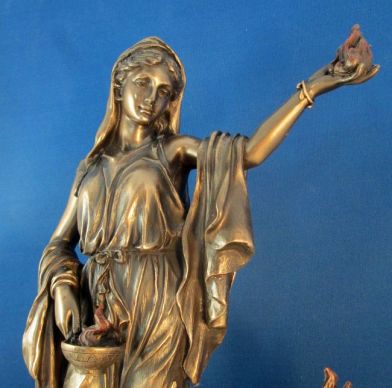 Daughter of Kronos, venerable dame,
Daughter of Kronos, venerable dame,
who dwellest amidst great fire’s eternal flame;
in sacred rites these ministers are thine,
mystics much blessed, holy and divine.
In thee the Gods have fixed their dwelling place,
strong, stable basis of the mortal race.
Eternal, much formed, ever florid queen,
laughing and blessed, and of lovely mien;
accept these rites, accord each just desire,
and gentle health and needful good inspire.
–Orphic Hymn 84 to Hestia
We begin with Hestia because She is the center around which Olympos revolves. Hestia takes part in few myths, yet it would be arguable that no Deity received more worship then Her. The lack of stories about Her is due to Her nature – Hestia values not power, nor change and adventure, but peace and tranquility. She is almost always depicted veiled. Whether shown sitting or standing, She has remarkable posture. Her face is serene and calm, gentle and dignified.
Hestia takes part in few myths, yet it would be arguable that no Deity received more worship then Her. The lack of stories about Her is due to Her nature – Hestia values not power, nor change and adventure, but peace and tranquility. She is almost always depicted veiled. Whether shown sitting or standing, She has remarkable posture. Her face is serene and calm, gentle and dignified.
Some may consider this Goddess of the home a sexist patriarchal hold-over, an ancient Greek predecessor to the Victorian “angel in the house”. Having only freed ourselves roughly fifty years ago, women especially may find Hestia distressing, perhaps preferring more independent Goddesses such as Athena or Artemis. I myself once had an uneasy truce, of sorts, with Hestia. I was aware of Her importance in Greece, but I still found myself uninterested in Her in all but the most superficial ways.
Then, in January of 2007, I lost my job, and found that I was no longer the breadwinner. After a few weeks of enjoying my freedom to sleep in and do whatever I pleased, I began to panic at perceived my loss of independence. No longer were my then-boyfriend and I equal partners in paying the bills. Despite my (admittedly rather paltry) unemployment checks, I saw myself as completely dependent on him. There were few jobs immediately available in the struggling economy of my little town, and I had no wish to trudge through the deep-shifting snows of January in Michigan to find them. It didn’t help that I lacked a car, and so had to walk if my boyfriend or my brother were not around to lend me transportation. In my desperation, I reached out to Hestia to try to help me deal with my newfound position as “housewife” (house-girlfriend?).
What I found is that Hestia is not simply a patriarch’s deified image of the perfect wife. Rather, She is the glue that holds communities together. The majority of Hestia’s worship took place in the home, as is appropriate for a Goddess Who protects home and family. No Greek went a day without at least one moment of contact with this Goddess. She was the first divinity that a Greek baby was introduced to, as the newborn baby was carried around the hearth before he or she was accepted by the family. The first bite of every meal was sacrificed to Hestia by throwing it onto the fireplace, where it was consumed by the flame. Hestia is the Goddess that keeps families, and by extension, societies together.
The public hearth, or prytaneum, was the center of every Greek city the same way its private counterpart was the center of every home. The house was built around the hearth. The fire was always burning, always tended to. When a girl married, her mother brought fire from her house to light the hearth of the home her daughter would share with her husband. When a city decided to establish a colony, the colonists would bring fire from the hearth of their mother city, to ensure a continuing connection between the two communities. The importance of Hestia’s fire cannot be underestimated.
The fire would be extinguished in times of mourning, such as a death in the family or the end of a household. But for it to go out on its own was never good, and was usually considered a bad omen. Ginnette Paris, in her book Pagan Meditations: the Worlds of Aphrodite, Artemis, and Hestia, states that “If Hestia’s fire went out in the home or in a city of ancient Greece, the significance was tragic, and there were complex rituals for relighting it. Thus, when the Persians laid siege to Athens and extinguished the sacred fire, the Athenians, after defeating them, sent for fire at the great temple of Hestia at Delphi to re-kindle the fire of their own city.”[1]
Hestia and the Meaning of Family
An interesting aspect of Hestia is the fact that She is one of the Virgins – the three Olympian Goddesses Who never married. How can this be? The Goddess of hearth and home, the deity who values family above all else, never married?! The mythic reasoning for this is that both Her brother Poseidon and Her nephew Apollon sought Her hand in marriage. The two of Them, Who had formerly gotten along just fine, began to fight and quarrel. This so upset the peace-loving Hestia that She ran away, and swore to never marry. As Paris states “Her virginity is not so much a refusal of man as a refusal of the upheavals or marriage and conjugal life.”[2] Although few marriages are as tumultuous as that of Her siblings Zeus and Hera’s was in myth, all relationships come with some amount of upheaval and emotional turmoil. Marriage would require moving to Her new husband’s home, and in Poseidon’s case, that would be under the sea, far from Her life and family on Olympos. Sharing quarters with someone requires a degree of compromise and sacrifice.
So Hestia does not choose to have children and start a family of Her own, but instead finds  fulfillment in devoting Herself to the family She already has. It is only very recently that the nuclear family has come to dominate our Western world-view. Until the Industrial Revolution and the World Wars, it was not uncommon for three, sometimes four generations to dine at the same table. Mothers and fathers were not the only ones responsible for the raising of children, but aunts, uncles, and grandparents took part as well. Children were reared not only with siblings, but cousins as well, so they never lacked for a playmate. In that busy and stimulating environment, one need not detach from the family that bought you into the world, unless the desire is there already. There was no ugly image of the bitter and lonely “old maid”. When weighing the pros and cons of staying with the comfort and familiarity of this kind of family verses the risk and stress of breaking off to found your own dynasty, we begin to understand Hestia.
fulfillment in devoting Herself to the family She already has. It is only very recently that the nuclear family has come to dominate our Western world-view. Until the Industrial Revolution and the World Wars, it was not uncommon for three, sometimes four generations to dine at the same table. Mothers and fathers were not the only ones responsible for the raising of children, but aunts, uncles, and grandparents took part as well. Children were reared not only with siblings, but cousins as well, so they never lacked for a playmate. In that busy and stimulating environment, one need not detach from the family that bought you into the world, unless the desire is there already. There was no ugly image of the bitter and lonely “old maid”. When weighing the pros and cons of staying with the comfort and familiarity of this kind of family verses the risk and stress of breaking off to found your own dynasty, we begin to understand Hestia.
Honoring Hestia
The first portion of every meal and every public sacrifice was offered to Hestia. She often received a mention at the beginning of prayers and hymns. One of the Delphic Maxims is, after all, “Begin with Hestia”, meaning “Start at the beginning”.
Still, in my experience, Hestia is not a Goddess Who demands grand rituals. I believe that the best way to describe the worship of Hestia is “actions speak louder than words”. True worship of Hestia requires honoring Her in more than words, and keeping your home clean, bright and inviting. It is not necessary that your house be spotless – in fact, too sterile an environment is off-putting and decidedly anti-family.
Promoting an atmosphere of peace and tolerance is another act of worship for the peace-loving Hestia. Being a peacemaker can be quite a tall order at times. We are but human beings, and we cannot always stay above the fray. However, a refusal to take sides, as in  myth Hestia refused to take sides in the never-ending Olympian conflicts, can be the best way to keep peace in the home and keep problems from being exacerbated, especially in the case of family squabbles.
myth Hestia refused to take sides in the never-ending Olympian conflicts, can be the best way to keep peace in the home and keep problems from being exacerbated, especially in the case of family squabbles.
In coming to know Hestia, I came to understand a problem in society that many others have named, but I had not given much thought to. In too many families across the nation, the fire is dead. Divorce, that specter blamed for destroying a full half of all marriages, is not at fault. Divorce is merely a result, not a cause. To paraphrase Paris, a person cannot remain in a home where the fire no longer burns. The true tragedy is when a formal divorce may never come about, but the family is internally dead just the same. As a child of one of these shams of a marriage myself, I personally know what happens when Hestia is ignored.
There are many factors that contribute to this phenomenon. I’d like to take some time to discuss a few. Many families, especially those with teenagers, no longer eat together. The ubiquitous fast-food joints dotting the countryside turn meals into a lonely, assembly-line affair. Get in, get your food, get out. The act of breaking bread with others forms community. Why do you go out to eat on a first date? Because sharing food and conversation is the primary way of building relationships. Food is survival. Food is life. To share a meal is to share life.
Even architecture affects the people who live within. Standard suburban houses seem built more for show then for family. Large living rooms, three car garages and impeccably manicured lawns, which are in reality quite useless, are all status symbols. The actual family quarters, the bedrooms, the kitchen, tend to be smaller and more cramped. Too many so-called “family homes” are not built for bringing families together but to show off. The more “outward-focused” the house, the more at risk the family is of being disconnected from each other. Ginette Paris states the issue like this:
The living-room, which serves more for social then for family life, is in some houses more spacious and luxurious than the rooms used by the whole family. As for the kitchen, still the domain of women and children, only recently have the architects, decorators, and the women themselves given it as much attention as the more “noble” rooms in the house. There are also houses that are little more than crash-pads, and those who evolve in them feel indeed that their home is without life. Inevitably, in such homes the woman is considered, and considers herself, a servant rather than a Hestia.[3]
Meanwhile, the household television has become the focal point of our living rooms, holding the place of honor once reserved for the family hearth. “Think of any image from history that depicts a happy home, and invariably it shows a family grouped around a hearth[4]” comments A. Bronwyn Llewellyn, the author of “Goddess At Home”. She goes on to say that this image endures, even in an era where few houses have fireplaces and the television, or perhaps the kitchen refrigerator, is indeed where the family gathers.
In coming to honor Hestia, I became aware of how Western culture has truly devalued  women and the family. Despite politicians’ never-ending talk of family values, we as a culture do not really believe that family and children are important. If we did, we would make every effort to ensure that the millions of families living below the poverty line had adequate health care (if only for the children of these families), that all parents had the option of paid paternity/maternity leave if they so desired, tax incentives for corporations that provide childcare for their employees, and better education for everyone, not just the rich.
women and the family. Despite politicians’ never-ending talk of family values, we as a culture do not really believe that family and children are important. If we did, we would make every effort to ensure that the millions of families living below the poverty line had adequate health care (if only for the children of these families), that all parents had the option of paid paternity/maternity leave if they so desired, tax incentives for corporations that provide childcare for their employees, and better education for everyone, not just the rich.
Hestia speaks with a “we”, not an “I”. She is the family, the city, the collective. Hestia is the Goddess of community, and She is pleading with us to return to a more communal way of living. We must acknowledge Hestia to find peace in our homes again. Fire is an apt symbol of this sense of community that many today have lost, but many others working to rekindle. Llewellyn correctly states that “Like people, pets, plants or relationships, you must tend to [fire] or it dies.”[5]
[1]Paris, Ginette. Pagan Meditations: The Worlds of Aphrodite, Artemis and Hestia. Spring Publications. 1986. Woodstock, Connecticut. Pg 168
[2]Paris, Ginette. Pagan Meditations: The Worlds of Aphrodite, Artemis and Hestia. Spring Publications. 1986. Woodstock, Connecticut. Pg 185
[3] Paris, Ginette. Pagan Meditations: The Worlds of Aphrodite, Artemis and Hestia. Spring Publications. 1986. Woodstock, Connecticut. Pg 170
[4] Llewellyn, A. Bronwyn. Goddess At Home: Divine Interiors Inspired by Aphrodite, Artemis, Athena, Demeter, Hera, Hestia, & Persephone. Rockport Publishers. 2003. Gloucester, Massachusetts. Pg 108
[5] Llewellyn, A. Bronwyn. Goddess At Home: Divine Interiors Inspired by Aphrodite, Artemis, Athena, Demeter, Hera, Hestia, & Persephone. Rockport Publishers. 2003. Gloucester, Massachusetts. Pg 108